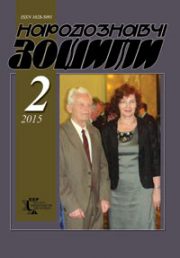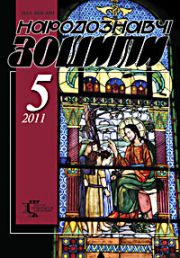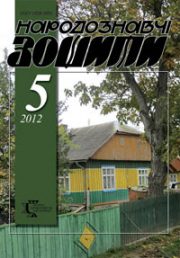The Ethnology Notebooks. 2025. № 5 (185), 1299—1307
UDK811.111:81’37:004.42
THE LANGUAGE OF ENGLISH SOCIAL NETWORKS: NEOLOGISMS, SLANG, GRAPHIC ABBREVIATIONS
ZAITSEVA Kateryna
- ORCID ID: https://orcid.org/0000-0001-7171-4826
- Candidate of Pedagogical Sciences,
- Associate Professor of the Department of Germanic Philology
- and Methods of Teaching Foreign Languages,
- South Ukrainian National Pedagogical University named after K.D. Ushynsky
- Contacts: 26, Staroportofrankivska St., 65020, Odesa, Ukraine
VELYKA Alina
- ORCID ID: https://orcid.org/0000-0003-0747-1932
- Senior lecturer of the Department of the Slavic
- and the Germanic Philology and Translation,
- Zhytomyr Ivan Franko State University,
- Contacts: 40 Velyka Berdychivska St., 10008, Zhytomyr, Ukraine
BIRIUKOVA Diana
- ORCID ID: https://orcid.org/0000-0002-1721-0122
- Candidate of Philological Sciences, Associate Professor,
- Associate Professor of the Department of Foreign Philology,
- Translation and Professional Language Training,
- University of Customs and Finance,
- Contacts: 2/4 Volodymyr Vernadsky St., 49000, Dnipro, Ukraine
Abstract. Introduction. Modern English is rapidly evolving under the influence of digital communication. Social networks like Facebook, Instagram, and Twitter promote linguistic innovation through new words, abbreviations, and stylistic devices. Problem Statement. Although neologisms in English have been widely studied, research on their use in social networks remains limited. Purpose. This study analyzes neologisms, slang, and graphic abbreviations in English social networks, examining their sources, formation, and communicative functions. Methods. Descriptive, comparative, and quantitative analyses were used to record examples from social media and determine usage frequency and differences from traditional language.Conclusions. English social networks are major sources of lexical innovation. Neologisms often arise through compounding, clipping, and conversion; slang adds expressiveness; and graphic abbreviations enhance communication efficiency. Many new units quickly move from online to general usage.
Keywords: English language, social networks, neologisms, slang, graphic abbreviations, digital communication, word formation.
Received 25.09.2025
REFERENCES
- Lebedeva, A.V. (2021). Neologization of the lexical composition of the English language in the modern era. New Philology: Collection of Scientific Proceedings, 81 (Vol. 1, pp. 206—210). Retrieved from: https://journals.indexcopernicus.com/api/file/viewByFileId/2015285 [in Ukrainian].
- Namachynska, G., & Tsita, M. (2024). Neologisms in modern English-language periodicals. Bulletin of Science and Education, 11 (29). DOI: https://doi.org/10.52058/2786-6165-2024-11(29)-548-557 [in Ukrainian].
- Ostafiychuk, O.D. (2020). Neologisms of the English language in modern society. Scientific Notes of the V.I. Vernadsky Tavrichesky National University. Series: Philology. Social Communications, 3 (1) (Vol. 31 (70), pp. 156—160). Retrieved from: https://philol.vernadskyjournals.in.ua/journals/2020/3_2020/part_1/30.pdf [in Ukrainian].
- Khizhun, Ya., & Dyshleva, S. (2023). Neologisms of modern English: linguistic status and classification parameters. Modern Research in Foreign Philology, 1 (23), 150—160. DOI: https://doi.org/10.32782/2617-3921.2023.23.150-160 [in Ukrainian].
- Oxford English Dictionary. New word entries. Retrieved from: https://www.oed.com/information/updates/september-2023/new-word-entries/.
- Cambridge Dictionary. Neologism. Cambridge English Dictionary. Retrieved from: https://dictionary.cambridge.org/us/dictionary/english/neologism.
- Merriam-Webster. Neologism. Merriam-Webster Dictionary. Retrieved from: https://www.merriam-webster.com/dictionary/neologism.
- Wikipedia contributors. Oxford English Dictionary. Wikipedia, The Free Encyclopedia. Retrieved from: https://en.wikipedia.org/wiki/Oxford_English_Dictionary.
- Marshall, T. (2025). Neologism. Definition, Use & Examples. Scribbr. Retrieved from: https://www.scribbr.com/rhetoric/neologism/.
- The Global Language Monitor. How many words enter the English language each year. Atkins Bookshelf. Retrieved from: https://atkinsbookshelf.wordpress.com/tag/how-ma ny-words-enter-the-english-language-each-year/.
- Instagram — «i found my old finsta…». Retrieved from: https://www.instagram.com/p/DGKxRnHxLJX/.
- Twitter/X — Bebe Rexha mentions «finsta» in tweet. Retrieved from: https://twitter.com/BebeRexha/status/ 187 3774436614349221.
- Instagram — account/profile with «finsta» in the name. Retrieved from: https://www.instagram.com/finsta.app_/.
- Facebook — explanatory posts «STAN — what does STAN mean?». Retrieved from: https://www.facebook.com/ slangwiseblog/posts/-slang-of-the-day-stan-what-does-stan-mean-in-slang-ever-seen-someone-say-i-stan/122161409984564122/.
- Twitter/X — tweets with Gen-Z words (cap/no cap, sus, etc.). Retrieved from: https://twitter.com/onlythehost/status/.
- Twitter/X & Instagram — examples of «no cap» in tweets. Retrieved from: https://twitter.com/Suuwoogang/status/1763911036481003570; https://twitter.com/kdub27_/status/1828181482348912878.
- Instagram — post/reel with #TBT (Throwback Thursday). Retrieved from: https://www.instagram.com/p/DMyVbhFN6k-/.
- Instagram — reel «BRB. A Summer in Egypt…». Retrieved from: https://www.instagram.com/reel/DITuLHTs_Bh/.
- Instagram — reel/post «Ever seen abbreviations like ASAP, BRB, or FYI?». Retrieved from: https://www.instagram.com/reel/DM2v9tMy8vl/.
- Instagram — reel «Ever wondered what abbreviations like TYSM, BTW, W8, BRB, and ASAP mean?». Retrieved from: https://www.instagram.com/light.s_workshop/reel/DNLT74OO8qZ/.
- Twitter/X — examples of «CUL8R» (tweets, brand/track). Retrieved from: https://twitter.com/scorebook_bob/status/1287187376436117504; https://www.facebook.com/arizonazervas/posts/c-u-l8r-drops-this-fridaypre-save-now-arizonazervaslnktocul8r/.
- Instagram — profiles/reels with «CUL8R» (brand/hashtag). Retrieved from: https://www.instagram.com/cul8r_wear/.
- Twitter/X — examples of «HB2U» in tweets/Instagram posts. Retrieved from: https://twitter.com/bobuk/status/183 4498 720391422060; https://www.instagram.com/reel/DNAzW4ji Qtc/; https://www.facebook.com/colorsxstudios/videos/isaiah-rashad-hb2u-a-colors-show-snippet/.







